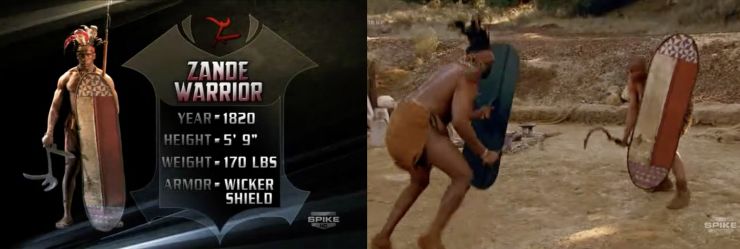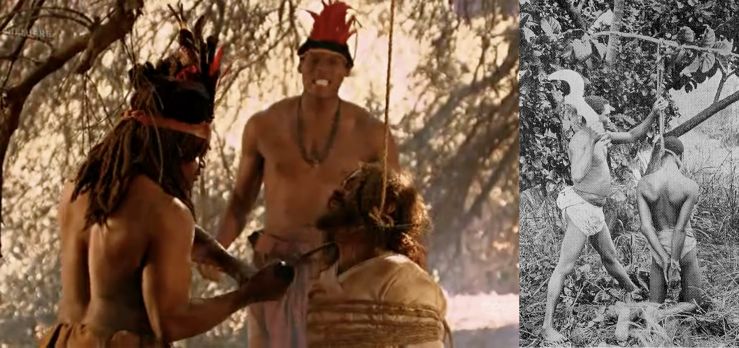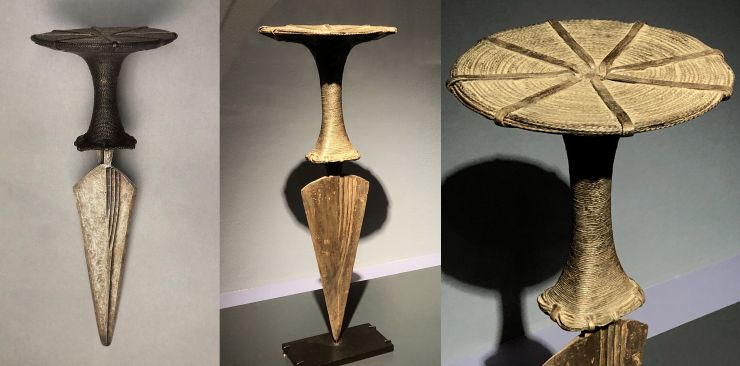Forged in Fire
“Makraka.” S4 Ep4, Apr 25 2017, History Channel.
In this episode, we encounter a fundamental flaw that must be addressed before evaluating the History Channel’s description. The makraka knife described in this episode is pictured below (left), and derived from a knife in the Pitt Rivers collection (right).

The Pitt Rivers database describes this knife as “Model / Throwing Knife / ?Toy. Cultural Group: Zande Local Name: Unknown.” [here]
However, a separate page from the Pitt Rivers Museum [here] describes the knife this way:
Small ‘model’ knife…
This object was sold to the museum by Cornelius Marinus Pleyte in 1899; it is not clear if he was also the original collector of the item.
Museum records state that 'this weapon is usually seen described as the MAKRAKA execution knife or hatchet but may be used by other ZANDE peoples.' Makraka is a term applied both to a place, and also a subdivision of the Zande, and it is not clear which was intended here.
For another Zande model knife, see 1899.85.2. For full sized versions of the same form, see 1884.25.6 (Zande or Mangbetu) and 1905.68.10 (Zande). Comparable knives are found amongst the Zande and Boa; some authors have seen these as having derived from the throwing knife, while Petherick claims these were used as projectiles (W. Fischer and M.A. Zirngibl, 1978, African Weapons, p. 61; they call this type a 'sabre knife'; C. Spring, 1993, African Arms and Armour, p. 86; he calls these ‘scimitars’; see also J. Petherick, 1860, On the Arms of the Arab and Negro Tribes of Central Africa, Bordering on the White Nile, Journal of the Royal United Service Institution IV no. 13, p. 176). They may have been dual purpose blades. For further full-size examples, said to be from the Democratic Republic of Congo, see 1909.65.5 and 1927.54.51.
The important takeaway from this text by Pitt Rivers is that the museum initially asserts the specific name and deadly function of the makraka. But then every other statement is either a step back or a contradiction: the provenance is unclear, the deadly use assertion cannot be confirmed by outside sources (which are listed), the museum isn’t certain if makraka describes a culture or a location, and the knife itself is a miniature model or a “?Toy.” Also noteworthy is that none of the five knives referenced as comps in the Pitt Rivers collection repeat the makraka name or the deadly narrative. Even the full-sized blades aren’t described as being used for executions, only the “?Toy” is.
To my knowledge, Pitt Rivers is the only one to assign the name makraka to this knife and the only one to assign the function as “execution hatchet.” There are numerous resources that describe this knife as a sickle known as mambeli. In African Arms and Armor (1993), one of the references cited by Pitt Rivers, Spring describes how Zande warriors would carry spears, shields, and throwing knives for use in war. He then states, “a senior man might have a large knife called mambeli at his waist as well, but he would be unlikely to use it on such an occasion as this [combat].” Below are photographs of some of the comps in the Pitt Rivers collection alongside objects from my archive, all of which should be labeled mambeli, and not makraka.

Here is the History Channel’s commentary on what they call “the makraka”:
The Makraka [INCORRECT NAME] is a sickle shaped weapon with its cutting edge on the inside curve of the blade [TRUE]. It was notably used by the Azande tribe, a dangerous clan that invaded and conquered central Africa in the early 1800s [TRUE with EXAGGERATIONS]. With the help of the makraka, they took no prisoners while defending their land and resources [FALSE]. The sword was often used in executions to remove limbs and decapitate intruders or enemies [FALSE and INVENTED]. The Azande’s fatal and terrorizing use of the Makraka is highlighted in the game “The Deadliest Warrior” [TRUE, the FALSE and INVENTED history was described there].
The singular description of this knife as an execution weapon by Pitt Rivers is clearly an aberration. The last sentence in the History Channel’s description demonstrates where they sourced their violent descriptions: from the Spike TV show known as “The Deadliest Warrior.”
The premise of “The Deadliest Warrior” was to compare warriors from different locations or periods in time who never interacted and hypothesize about “who would win in a battle to the death.” The show is laden with inaccuracies, exaggerations, and Hollywood inventions, and is difficult to take seriously. But since the episode “Aztec Jaguar vs. Zande Warrior” (S02E04, 11 May 2010) is the source of the information presented in the “Forged in Fire” episode discussed here, I’ll review it briefly.
The first and most noticeable problem with The Deadliest Warrior is their penchant for generalizations that play up the brutality and primitivism of both warriors. In describing the Zande, they call them:
· A ferocious barbarian of central Africa
· A 19th century killer whose lust for blood terrorized central Africa
· The [Zande] slaughter for punishment and power
· We Zandes just kill.
· For their ancestors, killing was a virtual instinct
A glaring error is that the show embraces the term “Niam Niam” for the Zande, which was a pejorative term assigned to them by outsiders. The Deadliest Warrior repeatedly shows their Zande experts claiming ownership of this offensive term:
They defeated and demoralized their opponents psychologically, from their weapons to their appearance. One of their fiercest tactics was to make their enemies believe they were cannibals. The Zandes actually went and filed their teeth to make it seem real that they can eat people. Such strategies caused the Zande warriors to be nicknamed “niam niam” which meant “great eaters.” So imagine that sound coming down the warpath: “Niam niam! Niam niam! Niam niam! Niam niam!” As they’re coming at you: “Niam niam! Niam niam!” Fierce!
Another error is that they depict Zande warriors holding and then fighting with shields that were not used by the Zande, but by the Ngandu or Saka. These cultural groups also inhabited the D.R. Congo, but their shields are distinct from Zande shields.

A significant flaw is that in describing the use of the fictional Makraka knife, they describe an Ngombe-style execution. While there is compelling evidence that the Ngombe executions themselves were largely exaggerated by Westerners, there is at least strong documentation that such stories originated from the Ngombe.
The so-called Zande expert describes the Ngombe-style execution this way:
This is the Makraka. The inside of the blade is the sharpened edge and it will cut across the neck smoothly. Picture this with me: you have a human head tied to a sapling tree, branches bent. The head is attached to the tree. You have the executioner taking a stance just like this. And with brute force, he would drive the sword through, and the head would go flying. Catch it, catch it, catch it—touchdown!
(The black and white photo below was staged for the camera by the Ngombe, and not an actual execution)

Another aspect that is problematic is the general Hollywoodization of everything. For example, all of the experts brought in for the show are just actors (see here). Then, these actors—representing cultural groups who never interacted—start taking jabs at each other back and forth:
Who the hell comes into battle with a piece of shit like that? They can barely even throw the thing!
All they care about is dancing around and trying to intimidate you. Nah ah. That shit don’t fly with me.
They fight for what? We fight for greater cause. We have the gods on our side. They fight for nothing.
Sorry Aztec warriors, maybe next time. Niam niam!

In summary, this program presents Hollywood actors who represent historic warriors that carry shields from the wrong culture, use knives that don’t exist in executions that were never conducted, all while shouting a derogatory term about their own culture. They present reenactments that are dramatized and historically inaccurate, and also “scientific tests” where they butcher human-shaped models that spew fake blood.

Its unfathomable that The History Channel would take information from another television program and present it as factual and historically accurate on its own program.
Finally, there is an African weapon that is widely labeled makraka and makaraka. It is a symmetrical dagger with an elaborately decorated, flared handle, clearly not meant for use. While it is often called makaraka, that term actually describes the cultural group from southern Sudan who made the blade, the Adio or Makaraka.
